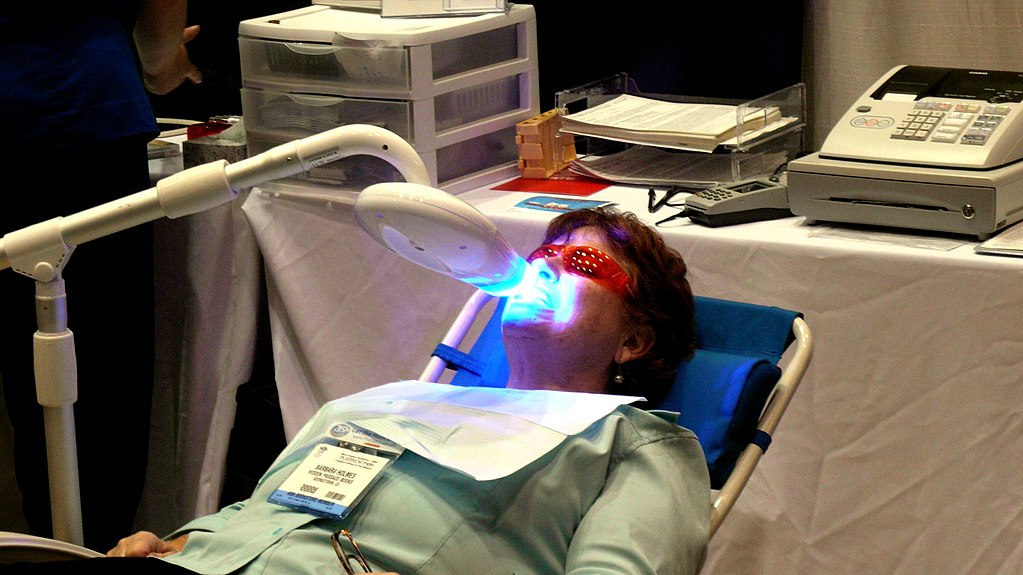When over-the-counter teeth whitening products don’t give the desired results, many people turn to their dentist for stronger options. Two teeth whitening treatments that are popular are Zoom! and laser teeth whitening.
At first glance, laser and Zoom! might seem the same. Both are professional treatments offered by dentists, and they do work with a similar concept. But there are some things that make them different.
What Zoom! and Laser Whitening Have in Common
Laser teeth whitening and Zoom! use a similar process to whiten teeth. Both procedures involve the application of a bleaching agent made with hydrogen peroxide to the teeth. A special dental instrument (Zoom! uses light rather than a laser) helps activate this gel solution. A chemical reaction called oxidation occurs, allowing the bleaching agent to penetrate the enamel of the tooth, scrubbing away stains.
A session of laser whitening typically takes just under an hour. Zoom! is about the same, but is normally done with three separate applications of gel with a 15-minute wait each time while the light does its work.
Most people get noticeable results from both whitening methods after just one visit to the dentist. Some people with more stubborn stains have to return a few times to get their teeth to the desired shade.
Another similarity is after-care and upkeep. Immediately after treatment, teeth can be more susceptible to staining than normal. It is suggested that patients avoid eating or drinking anything that could stain their teeth in the first week. This means no cup of coffee or plate of spaghetti for a while.
The dentist will also sometimes provide at-home whitening trays to maintain brightness. They are typically used for about a half-hour once a month. No matter what type of whitening used, it won’t last forever. Most patients need treatment to refresh whitening every six months or so.
How Zoom! Teeth Whitening Differs from Laser

The main way that Zoom! and laser teeth whitening differ is in the dental instrument used to activate the hydrogen peroxide solution.
Laser whitening’s name says it all. It uses a special laser tool to heat the bleaching solution. The heat helps the solution oxidize. The laser’s beam is small, so covering each tooth takes some time and skill for the dentist.
One drawback is that the excess heat can make the process uncomfortable for some patients. Teeth may inadvertently become overheated. The worst-case scenario could be nerve damage. Some people also don’t like the fact that there are some infrared emissions from the laser. Problems with laser teeth whitening are rare. Dentists follow strict protocols to protect teeth and surrounding tissue from the chemicals and the laser.
Zoom! works with a special ultraviolet light to activate the whitening gel. The light filters out most of the infrared emissions and minimizes the amount of heat exposure. Another significant difference is the shape of the instrument. The light covers an entire set of teeth, so the whitening happens all at once instead of one tooth at a time.
Teeth Whitening Results
Compared to at-home treatments like whitening strips, both Zoom! and laser teeth whitening both tend to get better results. Dentists are able to use a much stronger concentration of hydrogen peroxide than is available in over-the-counter products. Most store-bought items contain about 7-10% hydrogen peroxide, where dentists can use 25-35%.
Even though the methods used at the dentist’s office are stronger, results still vary from patient to patient. A lot depends on the cause of the tooth stains in question. Deeper stains that have penetrated the tooth enamel are harder to remove than surface stains caused by food and drink.
In general, laser and Zoom! whitening work best for yellow or brown stained teeth. Teeth may have a gray tint because of trauma or from drugs like tetracycline. Unfortunately, gray teeth might not respond to any treatment, whether store-bought or from the dentist. Sometimes the only way for whiter teeth is to get veneers.
Cautions for Zoom! and Laser Teeth Whitening

Teeth whitening products are safe, especially when administered by a dentist. There are some common-sense precautions to keep in mind, though.
First, whitening should only be done on healthy teeth. Before starting any treatments like Zoom! or laser teeth whitening, the dentist should require a full exam. Any cavities or other issues should be fixed first.
Dentists take precautions to protect the teeth and gums during teeth whitening. Because of the laser and ultraviolet light, patients are given eye protection to wear during the procedure. A barrier is also placed on the gums to keep the chemicals from burning them. Some people may still have a tingling sensation in their teeth or even a feeling like electric shocks towards the end of Zoom! or laser treatments. This typically wears off very quickly once it’s done. But if a patient has extreme tooth or gum sensitivity, the chemicals or heat from teeth whitening procedures can make it worse.
Children under the age of 13 should not have their teeth whitened. It is not recommended for pregnant or breastfeeding women either.
Zoom! and Laser Costs
The price of teeth whitening varies greatly from dentist to dentist and depends on the region. On average, the cost of Zoom! teeth whitening is about $500. Laser teeth whitening costs a bit more, sometimes as much as $1000. This is often because the size of the laser’s beam makes the process takes more time and care by the dentist.
Because prices can be so different across the country, it is best to consult with your dentist to find out your cost. If you need to find a dentist, our online database will locate someone who offers teeth whitening in your area.
Zoom! vs. Laser Teeth Whitening—Who Wins?
It is difficult to pick a clear winner when comparing Zoom! vs. laser teeth whitening. Both are similar, take about the same amount of time, and give comparable results. Instead, it usually comes down to a patient’s personal preference. In fact, it may be more important to choose a dentist rather than a treatment.
Dentists who offer teeth whitening typically offer the method that they feel gives their patients the best results. They become skilled at using their preferred products. When you have a dentist whom you trust, it makes sense to listen to their advice when it comes to what teeth whitening treatment they’d suggest for you.


